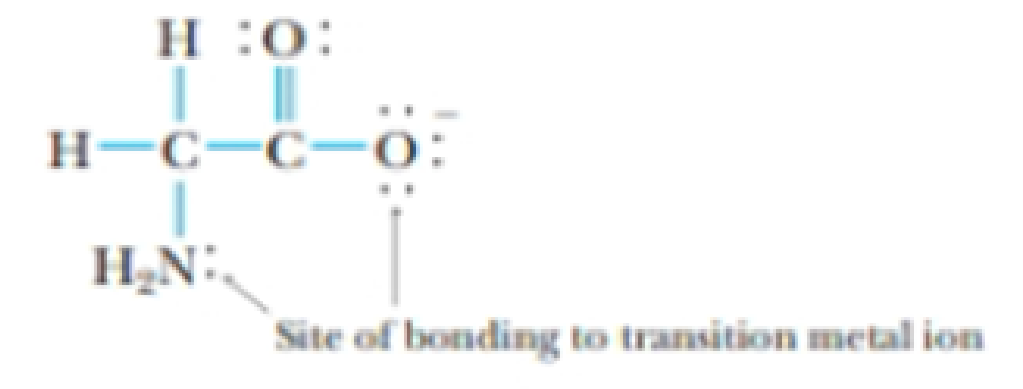
Chemistry & Chemical Reactivity
9th Edition
ISBN: 9781133949640
Author: John C. Kotz, Paul M. Treichel, John Townsend, David Treichel
Publisher: Cengage Learning
expand_more
expand_more
format_list_bulleted
Concept explainers
Textbook Question
Chapter 22, Problem 58GQ
The glycinate ion, H2NCH2CO2−, formed by deprotonation of the amino acid glycine, can function as a bidentate ligand, coordinating to a metal through the nitrogen of the amino group and one of the oxygen atoms.
Glycinate ion, a bidentate ligand

A copper complex of this ligand has the formula Cu(H2NCH2CO2)2(H2O)2. For this complex, determine the following:
(a) the oxidation state of copper
(b) the coordination number of copper
(c) the number of unpaired electrons
(d) whether the complex is diamagnetic or paramagnetic
Expert Solution & Answer
Trending nowThis is a popular solution!

Chapter 22 Solutions
Chemistry & Chemical Reactivity
Ch. 22.1 - Prob. 1RCCh. 22.2 - Prob. 1QCh. 22.2 - 2. Describe the unit cell of austenite.
Ch. 22.2 - Prob. 3QCh. 22.2 - Prob. 1RCCh. 22.2 - Prob. 2RCCh. 22.3 - (a) What is the formula of a complex ion composed...Ch. 22.3 - (a) Determine the metals oxidation number and...Ch. 22.3 - Name the following coordination compounds. (a)...Ch. 22.3 - Prob. 1RC
Ch. 22.3 - 2. What is the oxidation number of the metal in...Ch. 22.3 - Prob. 3RCCh. 22.3 - Prob. 4RCCh. 22.4 - What types of isomers are possible for the...Ch. 22.4 - Prob. 1RCCh. 22.4 - Prob. 2RCCh. 22.4 - Prob. 3RCCh. 22.4 - Prob. 4RCCh. 22.4 - Prob. 1QCh. 22.5 - Prob. 1CYUCh. 22.5 - Prob. 1RCCh. 22.5 - Prob. 2RCCh. 22.6 - Prob. 1QCh. 22.6 - Prob. 2QCh. 22.6 - Prob. 3QCh. 22.6 - Prob. 4QCh. 22.6 - Prob. 1CYUCh. 22.6 - Prob. 1RCCh. 22.6 - How are the d electrons of Pt distributed in a...Ch. 22.6 - What are the electron configurations for Nd and...Ch. 22.6 - Prob. 3CSCh. 22.6 - Prob. 4CSCh. 22.6 - Prob. 5CSCh. 22 - Prob. 1PSCh. 22 - Prob. 2PSCh. 22 - Identify a cation of a first series transition...Ch. 22 - Match up the isoelectronic ions on the following...Ch. 22 - Prob. 5PSCh. 22 - Prob. 6PSCh. 22 - Which of the following ligands is expected to be...Ch. 22 - One of the following nitrogen compounds or ions is...Ch. 22 - Prob. 9PSCh. 22 - Prob. 10PSCh. 22 - Prob. 11PSCh. 22 - Prob. 12PSCh. 22 - Prob. 13PSCh. 22 - Prob. 14PSCh. 22 - Prob. 15PSCh. 22 - Prob. 16PSCh. 22 - Give the name or formula for each ion or compound,...Ch. 22 - Prob. 18PSCh. 22 - Prob. 19PSCh. 22 - Prob. 20PSCh. 22 - Prob. 21PSCh. 22 - Prob. 22PSCh. 22 - Prob. 23PSCh. 22 - Prob. 24PSCh. 22 - Prob. 25PSCh. 22 - Prob. 26PSCh. 22 - Prob. 27PSCh. 22 - Prob. 28PSCh. 22 - Prob. 29PSCh. 22 - Prob. 30PSCh. 22 - In water, the titanium(III) ion, [Ti(H2O)6]3+, has...Ch. 22 - Prob. 32PSCh. 22 - Prob. 33GQCh. 22 - Prob. 34GQCh. 22 - How many unpaired electrons are expected for...Ch. 22 - Prob. 36GQCh. 22 - Which of the following complex ions is (are)...Ch. 22 - Prob. 38GQCh. 22 - How many geometric isomers are possible for the...Ch. 22 - For a tetrahedral complex of a metal in the first...Ch. 22 - Prob. 41GQCh. 22 - Prob. 42GQCh. 22 - Prob. 43GQCh. 22 - A platinum-containing compound, known as Magnuss...Ch. 22 - Prob. 45GQCh. 22 - Prob. 46GQCh. 22 - Prob. 47GQCh. 22 - How many geometric isomers of the complex ion...Ch. 22 - Prob. 49GQCh. 22 - Prob. 50GQCh. 22 - Prob. 51GQCh. 22 - The square-planar complex Pt(en)Cl2 has chloride...Ch. 22 - The complex [Mn(H2O)6]2+ has five unpaired...Ch. 22 - Experiments show that K4[Cr(CN)6] is paramagnetic...Ch. 22 - Give a systematic name or the formula for the...Ch. 22 - When CrCI3 dissolves in water, three different...Ch. 22 - Prob. 57GQCh. 22 - The glycinate ion, H2NCH2CO2, formed by...Ch. 22 - Prob. 59GQCh. 22 - Nickel and palladium both form complexes of the...Ch. 22 - The transition metals form a class of compounds...Ch. 22 - Cerium, as noted in Applying Chemical Principles:...Ch. 22 - Prob. 64GQCh. 22 - Two different coordination compounds containing...Ch. 22 - Prob. 71SCQCh. 22 - Prob. 69SCQCh. 22 - Prob. 70SCQ
Knowledge Booster
Learn more about
Need a deep-dive on the concept behind this application? Look no further. Learn more about this topic, chemistry and related others by exploring similar questions and additional content below.Recommended textbooks for you
 Chemistry & Chemical ReactivityChemistryISBN:9781337399074Author:John C. Kotz, Paul M. Treichel, John Townsend, David TreichelPublisher:Cengage Learning
Chemistry & Chemical ReactivityChemistryISBN:9781337399074Author:John C. Kotz, Paul M. Treichel, John Townsend, David TreichelPublisher:Cengage Learning Chemistry & Chemical ReactivityChemistryISBN:9781133949640Author:John C. Kotz, Paul M. Treichel, John Townsend, David TreichelPublisher:Cengage Learning
Chemistry & Chemical ReactivityChemistryISBN:9781133949640Author:John C. Kotz, Paul M. Treichel, John Townsend, David TreichelPublisher:Cengage Learning Chemistry: Principles and PracticeChemistryISBN:9780534420123Author:Daniel L. Reger, Scott R. Goode, David W. Ball, Edward MercerPublisher:Cengage Learning
Chemistry: Principles and PracticeChemistryISBN:9780534420123Author:Daniel L. Reger, Scott R. Goode, David W. Ball, Edward MercerPublisher:Cengage Learning Chemistry: An Atoms First ApproachChemistryISBN:9781305079243Author:Steven S. Zumdahl, Susan A. ZumdahlPublisher:Cengage Learning
Chemistry: An Atoms First ApproachChemistryISBN:9781305079243Author:Steven S. Zumdahl, Susan A. ZumdahlPublisher:Cengage Learning
 ChemistryChemistryISBN:9781305957404Author:Steven S. Zumdahl, Susan A. Zumdahl, Donald J. DeCostePublisher:Cengage Learning
ChemistryChemistryISBN:9781305957404Author:Steven S. Zumdahl, Susan A. Zumdahl, Donald J. DeCostePublisher:Cengage Learning

Chemistry & Chemical Reactivity
Chemistry
ISBN:9781337399074
Author:John C. Kotz, Paul M. Treichel, John Townsend, David Treichel
Publisher:Cengage Learning

Chemistry & Chemical Reactivity
Chemistry
ISBN:9781133949640
Author:John C. Kotz, Paul M. Treichel, John Townsend, David Treichel
Publisher:Cengage Learning

Chemistry: Principles and Practice
Chemistry
ISBN:9780534420123
Author:Daniel L. Reger, Scott R. Goode, David W. Ball, Edward Mercer
Publisher:Cengage Learning

Chemistry: An Atoms First Approach
Chemistry
ISBN:9781305079243
Author:Steven S. Zumdahl, Susan A. Zumdahl
Publisher:Cengage Learning


Chemistry
Chemistry
ISBN:9781305957404
Author:Steven S. Zumdahl, Susan A. Zumdahl, Donald J. DeCoste
Publisher:Cengage Learning
The Bohr Model of the atom and Atomic Emission Spectra: Atomic Structure tutorial | Crash Chemistry; Author: Crash Chemistry Academy;https://www.youtube.com/watch?v=apuWi_Fbtys;License: Standard YouTube License, CC-BY